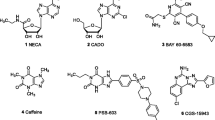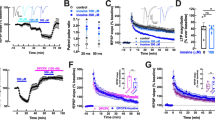Summary
Adenosine analogs such as 5′-N-ethylcarboxamide adenosine and N6-cyclohexyladenosine stimulate or inhibit adenosine cyclase activity in preparations of rat striatum depending on the assay conditions. N6-cyclohexyladenosine inhibits but does not stimulate adenosine cyclase activity in preparations of hippocampus. These findings suggest that the striatum contains both R a (stimulatory) and R i (inhibitory) adenosine receptors while the hippocampus contains only R i receptors. We have previously shown that [3H]N6-cyclohexyladenosine binds to R i receptors in rat hippocampus (Yeung and Green 1983). Comparisons of the characteristics of [3H]5′-N-ethylcarboxamide adenosine and [3H]N6-cyclohexyladenosine binding to hippocampus show that [3H]5′-N-ethylcarboxamide adenosine also binds to R i receptors with high affinity. [3H]5′-N-ethylcarboxamide adenosine binds to R i receptors in the striatum and to a second site that is present in striatum but not hippocampus. High affinity binding of both ligands to R i receptors can be blocked by treatments with N-ethylmaleimide that do not markedly affect [3H]5′-N-ethylcarboxamide adenosine binding to the second site in the striatum. The pharmacological characteristics of the second site indicate that it is the R a adenosine receptor.
Similar content being viewed by others
Abbreviations
- NEM:
-
N-ethylmaleimide
- Gpp(NH)p:
-
5′-guanylylimidodiphosphate
- NECA:
-
5′-N-ethylcarboxamide adenosine
- l-PIA:
-
N6-(l-phenylisopropyl)adenosine
- d-PIA:
-
N6-(d-phenylisopropyl) adenosine
- DPX:
-
1,3-diethyl-8-phenylxanthine
References
Anand-Srivastava MB, Johnson RA (1980) Regulation of adenosine-sensitive adenylate cyclase from rat brain striatum. J Neurochem 35:905–914
Bennett JP Jr (1978) Methods in binding studies. In: Yamamura HI, Enna SJ, Kuhar MJ (eds) Neurotransmitter receptor binding. Raven Press, New York, pp 57–90
Bruns RE (1980) Adenosine receptor activation in human fibroblasts: nucleoside agonists and antagonists. Can J Physiol Pharmacol 28:673–691
Bruns RF, Daly JW, Snyder SH (1980) Adenosine receptors in brain membranes: Binding of N6-cyclohexyl [3H] adenosine and 1,3-diethyl-8-[3H] phenylxanthine. Proc Natl Acad Sci USA 77:5547–5551
Cooper DMF (1982) Bimodal regulation of adenylate cyclase. FEBS Lett 138:157–163
Cooper DMF, Londos C (1979) Evaluation of the effects of adenosine on hepatic and adipocyte adenylate cyclase under conditions where adenosine is not generated endogenously. J Cyclic Nucleotide Res 5:289–302
Cooper DMF, Londos C, Rodbell M (1980) Adenosine receptor-mediated inhibition of rat cerebral cortical adenylate cyclase by a GTP-dependent process. Mol Pharmacol 18:598–601
Daly JW (1982) Adenosine receptors: Targets for future drugs. J Med Chem 25:197–207
Daly JW, Nimitkitpaisan Y, Pons F, Bruns RF, Smellie F, Skolnick P (1979) Binding sites for adenosine analogs: Possible relationship to cyclic AMP generating systems in brain tissue. Pharmacologist 21:253
Harden TK, Scheer AG, Smith MM (1982) Differential modification of the interaction of cardiac muscarinic cholinergic and beta adrenergic receptors with a guanine nucleotide binding component(s). Mol Pharmacol 21:570–580
Jakobs KH, Lasch P, Minuth M, Aktories K, Schultz G (1982) Uncoupling of α-adrenoceptor-mediated inhibition of human platelet adenylate cyclase by N-ethylmaleimide. J Biol Chem 257:2829–2833
Jones DH, Matus AI (1974) Isolation of synaptic plasma membrane from brain by combined flotation-sedimentation density gradient centrifugation. Biochem Biophys Acta 356:276–287
Kilpatrick BF, DeLean A, Caron MC (1982) Dopamine receptors of the porcine anterior pituitary gland. Effects of N-ethylmaleimide and heat on ligand binding mimic the effects of guanine nucleotides. Mol Pharmacol 22:298–303
Limbird L (1981) Activation and attenuation of adenylate cyclase activity. Biochem J 195:1–13
Londos C, Wolff J (1977) Two distinct adenosine-sensitive sites on adenylate cyclase. Proc Natl Acad Sci USA 74:5482–5486
Londos C, Cooper DMF, Schlegel W, Rodbell M (1978) Adenosine analogs inhibit adipocyte cyclase by a GTP-dependent process: basis for actions of adenosine and methylxanthine on cAMP production and lipolysis. Proc Natl Acad Sci USA 75:5362–5366
Londos C, Cooper DMF, Wolff J (1980) Subclasses of external adenosine receptors. Proc Natl Acad Sci USA 77:2551–2554
Londos C, Wolff J, Cooper DMF (1981) Adenosine as a regulator of adenylate cyclase. In: Brunstock G (ed) Receptors and recognition. Series B, vol 12. Chapman and Hall Ltd., London, pp 287–323
Lowry OH, Rosebrough NJ, Farr AI, Randall RJ (1951) Protein measurement with Folin phenol reagent. J Biol Chem 193:265–275
Munson PJ, Rodbard P (1980) LIGAND: A versatile computerized approach for characterization of ligand-binding systems. Anal Biochem 107:220–239
Murray TF, Cheney DL (1982) Neuronal location of N6-cyclohexyl-[3H] adenosine binding sites in rat and guinea pig brain. Neuropharmacology 21:576–580
Patel J, Marangos PJ, Stivers J, Goodwin FK (1982) Characterization of adenosine receptors in brain using N6-cyclohexyl [3H] adenosine. Brain Res 237:203–214
Premont J, Perez M, Bockaert J (1977) Adenosine-sensitive adenylate cyclase in rat striatal homogenates and its relationship to dopamine- and Ca2+-sensitive adenylate cyclases. Mol Pharmacol 13:662–670
Premont J, Perez M, Blanc G, Tassin J-P, Thierry A-M, Herve D, Bockaert J (1979) Adenosine-sensitive adenylate cyclase in rat brain homogenates: Kinetic characteristics, specificity, topographical subcellular and cellular distribution. Mol Pharmacol 16:790–804
Riggs DR, (1963) The mathematical approach to physiological problems. Williams and Wilkins Co., Baltimore, MD, USA
Schütz W, Tuisl E, Kraupp O (1982) Adenosine receptor agonists: Binding and adenylate cyclase stimulation in rat liver plasma membranes. Naunyn-Schmiedeberg's Arch Pharmacol 319: 34–39
Schwabe U, Trost T (1980) Characterization of adenosine receptor in rat brain by (−)-[3H]N6-phenylisopropyladenosine. Naunyn-Schmiedeberg's Arch Pharmacol 313:179–187
Stadel JM, Lefkowitz RJ (1979) Multiple reactive sulfhydryl groups modulate the function of adenylate cyclase coupled beta adrenergic receptors. Mol Pharmacol 16:709–718
Trost T, Schwabe U (1981) Adenosine receptors in fat cells. Identification of (−)-N6-[3H] phenylisopropyladenosine binding. Mol Pharmacol 19:228–235
Williams M, Risley EA (1980) Biochemical characterization of putative central purinergic receptors by using 2-chloro-[3H]adenosine, a stable analog of adenosine. Proc Natl Acad Sci USA 77:6892–6896
Wu PH, Phillis JW, Balls K, Rinaldi B (1980) Specific binding of 2-[3H] chloroadenosine to rat brain cortical membranes. Can J Physiol Pharmacol 58:576–579
Yeung S-MH, Green RD (1983) Agonist and antagonist affinities for inhibitory adenosine receptors are reciprocally affected by 5′-guanylylimidodiphosphate or N-ethylamaleimide. J Biol Chem 258:2334–2339
Author information
Authors and Affiliations
Rights and permissions
About this article
Cite this article
Yeung, SM.H., Green, R.D. [3H]5′-N-ethylcarboxamide adenosine binds to both Ra and Ri adenosine receptors in rat striatum. Naunyn-Schmiedeberg's Arch. Pharmacol. 325, 218–225 (1984). https://doi.org/10.1007/BF00495947
Received:
Accepted:
Issue Date:
DOI: https://doi.org/10.1007/BF00495947




